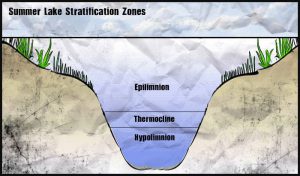There are several definitions of a lake. Dr. Milt Ostronfsky is a limnologist (he studies lakes) at Allegheny College in Meadville, PA. In his classes a lake is “a hole in the ground that’s full of water.” Other limnologists only consider a water body a lake if the water doesn’t completely change over, or “flush,” ten times a year or more. Another definition says a lake must be at least 10 acres in surface water size.
There are several definitions of a lake. Dr. Milt Ostronfsky is a limnologist (he studies lakes) at Allegheny College in Meadville, PA. In his classes a lake is “a hole in the ground that’s full of water.” Other limnologists only consider a water body a lake if the water doesn’t completely change over, or “flush,” ten times a year or more. Another definition says a lake must be at least 10 acres in surface water size
The water is lakes is layered. The top layer of water is the warmest in the spring and summer because of the sunlight hitting the surface of the water. In the winter this becomes the coldest layer (this is where you get your lake ice for skating and ice fishing). There’s less sunlight and generally more wind in the winter. The wind cools the top layer of water further and causes the water to turn over, or mix, causing the colder water to be moved toward the top.
winter. The wind cools the top layer of water further and causes the water to turn over, or mix, causing the colder water to be moved toward the top.
The middle layer is the buffer and the area subject to the quickest temperature change. In the winters this is the layer that tends to mix with the top layer.
The bottom layer remains at a fairly constant temperature. This layer will be the coldest in the summer, but doesn’t cool off too much in the winter. While you may have a lake freeze over, you’ll rarely see the bottom layer freeze.
http://www.untamedscience.com/bio…/biomes/lakes-ponds-biome/

